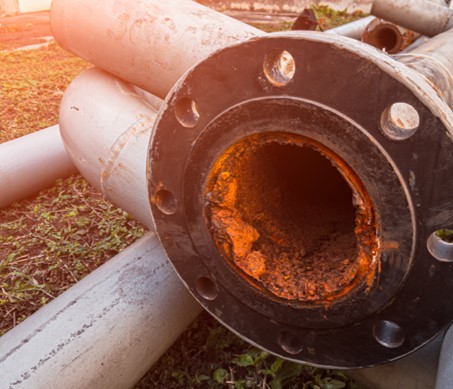Mechanism Of Corrosion and various forms of corrosion

Did You Know
Forms of corrosion are analogous
to different failure mechanisms
There are several forms of corrosion, also referred to as modes or mechanisms of corrosion. Sub-forms can also be identified for several forms of corrosion. The different forms and subforms of corrosion are analogous to different failure mechanisms in the mechanical world (fast fracture, fatigue, ductile tearing, brittle cleavage, wear etc.).
The primary mechanism of corrosion is electrochemical in nature, occurring when metals are exposed to electrolytes such as water or moisture.
The chemical reaction for rusting can be expressed as follows:
where:
Fe(s) represents solid iron atoms.
O2(g) represents oxygen molecules.
H2O(l) represents water molecules.
Fe2O3·xH2O(s) represents hydrated ferric oxide, also known as rust.
Electrochemical corrosion mechanism
Electrochemical corrosion is a natural process occurred by electron flow that shows how metals deteriorate in the presence of electrolyte which emphasize why we must understand and reduce this mechanism for effective corrosion control.
The process of electrochemical corrosion relate to oxidation of metals in the presence of electrolytes, mainly water or aqueous solutions.
Corrosion is usually controlled by
protective coatings & corrosion inhibitors
Lacquers and "quick-dry" paints are
most susceptible to Filiform Corrosion
Following are the forms of corrosion based on the visual appearance of corrosion damage.
Uniform Corrosion:
Uniform (or general) corrosion refers to the relatively uniform reduction of thickness over the surface of a corroding material. Uniform corrosion is usually controlled by selecting suitable materials, protective coatings, cathodic protection, and corrosion inhibitors.
Pitting Corrosion:
Pitting corrosion is a localized form of corrosion; the bulk of the surface remains un-attacked. Pitting is often found in situations where resistance against general corrosion is conferred by passive surface films. Localized pitting attacks are found where these passive films have broken down.
Crevice Corrosion:
Crevice corrosion is a localized form of corrosion, under the influence of "crevice geometries". Well-known examples of such geometries include flanges, gaskets, dis-bonded linings/coatings, fasteners, lap joints and surface deposits.
Stress Corrosion Cracking (SCC):
Stress corrosion cracking (SCC) is a form of localized damage that refers to cracking under the combined influence of tensile stress and a corrosive environment. The macroscopic fracture appearance tends to be of the "brittle" type, even if the metal/alloy is of a mechanically ductile variety.
Galvanic Corrosion:
Galvanic corrosion tends to occur when dissimilar conducting materials are connected electrically and exposed to an electrolyte. The following fundamental requirements, therefore, have to be met for galvanic corrosion:
- Dissimilar metals (or other conductors, such as graphite).
- Electrical contact between dissimilar conducting materials (can be direct contact or a secondary connection such as a common grounding path).
- Electrolyte (the corrosive medium) in contact with the dissimilar conducting materials.
Filiform Corrosion:
This type of corrosion occurs under painted or plated surfaces when moisture permeates the coating. Lacquers and "quick-dry" paints are most susceptible to the problem. Their use should be avoided unless the absence of an adverse effect has been proven by field experience. Where a coating is required, it should exhibit low water vapour transmission characteristics and excellent adhesion. Zinc-rich coatings should also be considered for coating carbon steel because of their cathodic protection quality.
Intergranular Corrosion:
Intergranular corrosion is an attack on or adjacent to the grain boundaries of a metal or alloy. A highly magnified cross-section of most commercial alloys will show its granular structure. This structure consists of quantities of individual grains, and each of these tiny grains has a clearly defined boundary that chemically differs from the metal within the grain centre. Heat treatment of stainless steel and aluminium alloys accentuates this problem.
Fretting Corrosion:
The rapid corrosion that occurs at the interface between contacting, highly loaded metal surfaces when subjected to slight vibratory motions is known as fretting corrosion.
This type of corrosion is most common in bearing surfaces in machinery, such as connecting rods, splined shafts, and bearing supports and often causes fatigue failure. It can occur in structural members such as trusses where highly loaded bolts are used and some relative motion occurs between the bolted members.
Exfoliation Corrosion:
An exfoliation is a form of intergranular corrosion. It manifests itself by lifting the surface grains of a metal by the force of expanding corrosion products occurring at the grain boundaries just below the surface. It is visible evidence of intergranular corrosion and is most often seen on extruded sections where grain thickness is less than in rolled forms. This form of corrosion is common on aluminium, and it may occur on carbon steel.
Erosion Corrosion:
Erosion corrosion is the result of a combination of an aggressive chemical environment and high fluid-surface velocities. This can be the result of fast fluid flow past a stationary object, such as the case with the oil-field check valve, or it can result from the quick motion of an object in a stationary fluid, such as happens when a ship's propeller churns the ocean.
De-alloying:
De-alloying is a rare form of corrosion found in copper alloys, grey cast iron, and some other alloys. De-alloying occurs when the alloy loses the active component of the metal and retains the more corrosion resistant component in a porous "sponge" on the metal surface. It can also occur by the re-deposition of the noble component of the alloy on the metal surface.




